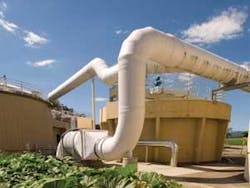Membrane Basics for Wastewater Treatment
By JB Neethling, Dave Clark and Marie-Laure Pellegrin
Used in drinking water for many years, membranes increasingly are being used in wastewater treatment as well. They can be used as pretreatment for reverse osmosis or in tertiary filtration. Membrane bioreactors are used as an integral part of wastewater treatment, creating high quality water for reuse. This article examines the regulatory drivers behind today’s increased membrane use, types of applications and design considerations in wastewater treatment, and the evolution of membrane technologies.
Membrane Treatment Drivers
There are a number of very good reasons to select membrane treatment for wastewater, and restrictive effluent discharge conditions are one of them. Restrictive discharge limits driven by total maximum daily loads (TMDL) and low effluent discharge requirements for nutrients such as phosphorus are becoming increasingly common. These conditions call for high levels of wastewater treatment, which membranes provide. For example, the state of Washington Department of Ecology prepared a TMDL for dissolved oxygen in the Spokane River that included in-stream phosphorus targets of 10 μg/L, among the nation’s lowest. This limit will be met by combining treatment technology to 50 μg/L with other phosphorus loading reductions.
Spokane River water quality conditions also affect the city of Coeur d’Alene, Idaho, where the Environmental Protection Agency set a 50 μg/L effluent phosphorus limit. A recent pilot test of four advanced filtration technologies (including membranes) in Coeur d’Alene found that all four systems were able to produce total phosphorus concentrations of less than 50 μg/L, however, none of them could deliver effluent phosphorus as low as the in-stream target of 10 μg/L.
Future regulations are expected to become even more restrictive. EPA is prioritizing a numeric nutrient standards program to reduce nutrient pollution, and the reference limits for both phosphorus and nitrogen in receiving waters are very low. Membranes are a great stepping stone for future discharge requirements and use as a pretreatment step for more advanced treatment methods such as reverse osmosis. This may be an important foundation for utilities to establish for programs that in the future may include groundwater recharge and indirect potable reuse.
In addition to nutrients such as nitrogen and phosphorus, microconstituents have gained national attention. These compounds include pharmaceuticals and personal care products and endocrine-disrupting chemicals. A study by the Water Environment Research Foundation (WERF) found that to a fairly significant extent, these compounds are being removed through conventional wastewater treatment processes. However, membrane systems usually have greater removal performances as a result of increased solids capture and long solids retention times (SRT) inherent in the membrane bioreactor (MBR) process.
The high-quality effluent produced by membranes is ideal for reuse programs, especially satellite MBR installations located in the collection system. This distributed system can collect high-quality water near the reuse demand by mining raw wastewater from the collection system and producing reuse quality water.
Membrane treatment also is an effective solution for constrained facility sites, which benefit from membrane technology because of the compact facilities, particularly in the MBR format. Many rapidly growing communities, such as Coeur d’Alene, have severely constrained spaces available for treatment facilities and benefit from compact treatment processes.
Design Considerations
The four critical design parameters to consider when incorporating membranes into treatment plant design are flux, transmembrane pressure, permeability and recovery.
First and foremost is flux, defined as the filtration rate per square foot of membrane surface area. The higher the flux design rate, the less surface area you need and the lower cost of installation. Transmembrane pressure (TMP) is the driving force or pressure needed to push or pull the water through the membrane itself. As the transmembrane pressure increases, the cost of running the membrane increases. Permeability is basically the quantity of water per square foot of membrane surface area that 1 psi can treat. Another way to think of it is the flux divided by the TMP. Recovery is the percentage of filter effluent vs. plant influent, and in some cases this is an important factor as well.
Other important design considerations include fluctuations in flow, temperature and feed quality. Unlike drinking water treatment where you have consistent water flow and quality, in a wastewater application you have inconsistencies that must be designed for. Cleaning requirements and replacement costs also need to be considered in the design.
Temperature affects flux in that as the feed water temperature drops, the water becomes more viscous, causing lower flux and higher cost. A favorable design condition would be one in which the temperature and flows are both higher in summer, such as a reuse application where demand for water is higher in the summer. This would make membrane use very favorable because the flux is higher when the temperature is higher, decreasing the cost of the system. A less favorable condition would be one where the flow is highest in the coldest months. This situation is not uncommon and is very often found in ski resorts or when the high flow of effluent coexists with the rainy season. When you have the highest flow at the lowest temperature, you need more membrane surface so it costs more.
Comparing Applications
To gain a better understanding of how membranes work, it can be useful to compare them to a conventional activated sludge system. A conventional activated sludge system typically has primary clarification, activated sludge, secondary clarification and filtration to produce high quality effluent. In an MBR, all the functions are combined into a single system. That makes it attractive because you have fewer systems to operate. The downside is there also are fewer barriers to removing a particular pollutant. A conventional activated sludge system provides more barriers through which to remove pollutants.
The advantages of an MBR system become clear when you compare layouts. A typical MBR footprint has primary clarifiers and the MBR system. A conventional activated sludge system has primary clarifiers, the aeration basin, secondary clarification and filtration.
Tertiary filtration is another application for membrane systems. A typical secondary treatment system is followed by a conventional sand granule media filter. The sand filter can be replaced by a membrane system to produce a high-quality effluent. The membrane system requires a smaller footprint compared to the sand filter. Many conventional sand filter systems can actually be retrofitted with submerged-media microfiltration systems and increase capacity, often doubling the amount of liquid that can be pushed through the structure.
One of the key issues in wastewater applications, particularly in reclamation applications, is pathogen removal. Viruses are on the nanometer scale, which means they are too small to be removed through a microfilter; some removal is possible through nanofilters or reverse osmosis. Yet if you look at performance data from microfilter systems you will find quite variable removal of viruses through microfiltration. That is because microfilters are very effective at removing particles, so any viruses associated with those particles also are removed.
Bacteria are larger, with the typical bacteria occurring at one micrometer in size. Since this is larger than the typical microfiltration unit, bacteria removal is very often achieved, typically at the detection limit. You may actually expect to see zero bacteria following microfiltration since the pore size is so small, however, practical applications show that even with a microfilter you may find occasional bacteria such as coliform downstream from the membrane.
Effluent turbidity is another key parameter in reclamation applications. Title 22 in California requires 0.2 nephlometric turbidity units (NTU) for membrane-filtered effluent. Using a microfilter for tertiary polishing typically achieves 0.06 NTU, which is handily below the Title 22 requirements.
MBR Technology Evolution
The MBR market is expanding rapidly. It first appeared on the radar screen in the mid 1990s, and today we have roughly 50 installations in operation greater than 1 mgd, and that number is expected to nearly double to 90 by 2011. There are currently around 130 million gallons per day (mgd) of MBR in operation greater than 1 mgd, which will more than double in 2011 to just over 300 mgd. This data, collected from the installation lists of GE-Zenon, Siemens-USFilter and Enviroquip-Kubota, shows that the size of the plants is getting larger as the market becomes more confident that the process is reliable.
When the wastewater industry first became interested in the technology there were three main manufacturers, all of whom are still in business today – Siemens, GE and Enviroquip. The challenge in designing an MBR plant is that each manufacturer has its own design. Siemens and GE use hollow fiber membranes by US Filter and Zenon, respectively, and Enviroquip uses the Kubota membrane with a flat-sheet configuration. In terms of specifications, the pore size for both Siemens and GE is 0.04 micron compared to 0.4 micron for Enviroquip, which relies on the biofilm growth on the membrane to reduce the effective pores size of their system.
The surface area per module also varies significantly by manufacturer. For example, Siemens provides 405 square feet vs. 13.45 square feet for Enviroquip’s bigger plate. Siemens seems to be most efficient at present in terms of footprint efficiency, measured in terms of the membrane surface area you can provide per plan area, since they can provide about 400 square feet of membrane per square foot of land, vs. 350 square feet for GE and 130 or 260 square feet for Enviroquip, depending on which plate is selected.
When expressed as flow per plan area, Siemens provides approximately 6,000 gallons per day (gpd) per square foot of land, compared to 5,000 gpd for GE and 2,000-4,000 for Enviroquip, again depending on the plate selected.
All of the vendors use similar design criteria as far as average flux is concerned, which is how they design for the average daily flow. They’re looking at designing about 15 gallons per square foot of membrane per day.
The technology has evolved significantly and the industry has benefited from lessons learned over the past 10 years as the technology has been applied. One thing that has changed is pretreatment requirements. When the technology first started being applied, the plants that were put on line did not have prescreens or fine screens at the front of the plant to prevent debris from becoming tangled in the membrane fibers. The configurations evolved from no screens to 6 millimeter screens to 3 millimeter screens and then to today’s standard, 2 millimeter or less perforated or fine mesh screens at the head of the plant.
Another change has been in the thickness of the fiber bundles. Ten years ago they ranged from one to two inches thick depending on the vendor. Fibers today have been reduced by a good one-fourth. When the fiber bundles were larger, the air carried in the membrane was not able to get into the middle of the fiber, resulting in some sludge packing and fouling.
Location of the membranes has also changed. They used to be located directly within the aeration basin but today’s standard is to actually put the membranes in a separate tank. This configuration provides more control over hydraulics and fouling, and makes it easier to clean the membranes because they can be cleaned in place.
Membrane costs and energy use are two important issues in MBR implementation. As the technology has matured, membrane replacement costs have decreased. In 1998, membranes cost $6 per square foot and by 2006, the price per square foot had dropped to less than $3. This trend will probably continue as the number of installations and capacity increases.
All of the vendors are conducting significant research and development to try to make the systems’ energy use more competitive with conventional activated sludge systems. Air scour is one of the biggest energy users in an MBR facility, and the air flows used today are less strong than they were 10 years ago. Expressed as scour per square foot of membrane, energy costs have dropped from 0.023 scfm to 0.013 scfm according to date provided by Siemens. To reduce costs further, vendors are experimenting with the amount of air provided and whether to provide it continuously or intermittently.
Some of the biggest current topics involving membranes, as gauged by incoming abstracts for the next WEF specialty conference, include membrane fouling and modeling, peak sensitivity for membrane design and hybrid systems. We may see more systems such as Brightwater in Washington state, which is a 40 mgd MBR currently under design. They are looking at using chemically enhanced primary clarifiers to take care of the peak flow, while the MBR will take care of the average daily flow, and they will blend these two strains together.
The industry is constantly evolving and it will be interesting to see what the next 10 years bring.
About the Authors:
- JB Neethling, P.E., Ph.D., is HDR’s national technical director of wastewater. He is based in the firm’s Folsom, CA, office.
- Dave Clark, P.E., is HDR’s national director of wastewater. He is based in the firm’s Boise, ID, office. <
- Marie Laure Pellegrin, Ph.D., is a wastewater project manager specializing in membrane bioreactors. She is based in the firm’s Kansas City, MO, office.


